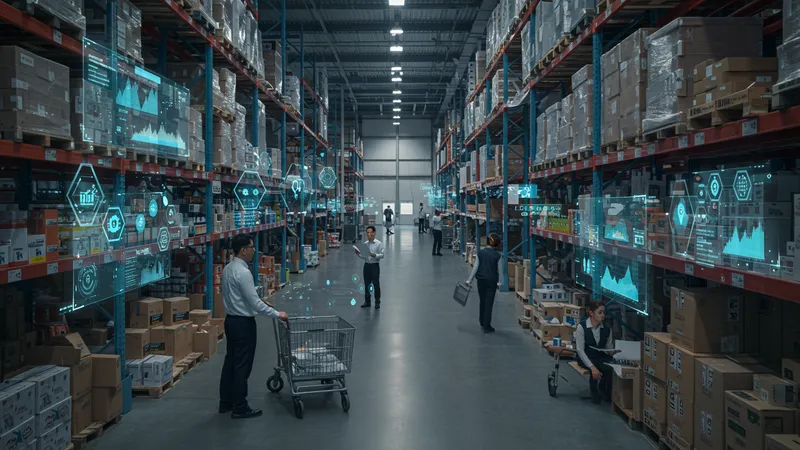

Imagine knowing what your customers want—before they even ask for it. That’s the promise behind accurate demand forecasting powered by advanced artificial intelligence within supply chain systems. At its core, this approach uses sophisticated algorithms and real-time data to anticipate consumer needs far more precisely than traditional forecasting methods. Instead of relying on outdated sales history or rough estimates, AI-powered supply chain insights continuously analyze vast datasets—like market trends, seasonality, social sentiment, and inventory fluctuations—to predict demand down to the product or region level.
By integrating AI capabilities into supply chain management, companies can adapt instantly to shifting consumer patterns and changing market dynamics. These intelligent systems spot anomalies—such as sudden spikes in demand driven by viral trends—almost as they happen, allowing organizations to monitor, adjust, and optimize supply faster than would ever be possible using manual forecasts. The result: minimized stockouts, reduced excess inventory, and sharper, more proactive decision-making at every stage.

AI-driven supply chain forecasting dramatically improves accuracy compared to manual or spreadsheet-based approaches. Recent studies indicate businesses utilizing these tools experience up to 50% less excess inventory and significantly fewer lost sales from out-of-stocks. Consider how global retailers now apply solutions like Lokad for daily SKU-level predictions—resulting in better shelf availability and streamlined replenishment.
What differentiates these platforms is their capacity to synthesize both internal data (historical sales, warehouse levels) and external sources (weather, promotions, economic indicators). For instance, SAS Demand Planning enables users to layer in real-world variables, allowing forecasts to be continually refined as new information arises—yielding plans that stay current and resilient.
Beyond the technology, true value is realized when these forecasts drive operational decisions. AI insights enable logistics teams to plan shipments precisely, finance leaders to optimize working capital, and merchandisers to calibrate campaigns to match supply realities. In fast-moving sectors, these proactive measures curb costly markdowns and prevent over-purchasing—direct results of knowing future demand more accurately.
Ultimately, AI-powered demand forecasting marks a shift from reactive guessing to strategic foresight. Companies that invest in such innovation enjoy reduced waste, improved customer satisfaction, and a competitive advantage built on real data. But to unlock the full potential, it’s crucial to explore the unique strengths—and challenges—of each system. The deeper details reveal even more valuable insights ahead…
Each AI-powered forecasting tool brings distinct strengths to supply chain optimization. SAS Demand Planning, with its strong analytics engine, is favored by enterprises that require robust scenario testing and intricate modeling capabilities across diverse product ranges. Its integrations support everything from shelf-level adjustments to long-term product launches, making it ideal for large organizations aiming for a holistic view.

Lokad appeals to retailers and manufacturers seeking granular, day-by-day demand forecasts delivered via the cloud for easy accessibility. The probabilistic algorithms effectively account for uncertainty, enabling teams to reduce safety stock while maintaining service levels. Lokad’s flexibility lets users scale solutions as their business evolves, offering a practical balance between precision and cost.
IBM Supply Chain Insights excels in environments demanding real-time, rapid-response forecasting. Leveraging machine learning, the platform interprets signals from inventory sensors, supplier networks, and external data feeds. It’s well-suited for companies managing global, fast-moving supply chains where responsiveness is mission critical for avoiding both shortages and surpluses.
Choosing among these tools often depends on data maturity and integration readiness. While SAS may appeal to those with expansive datasets and advanced analytics teams, Lokad’s out-of-the-box cloud setup works well for organizations yearning for speed and simplicity. IBM, meanwhile, stands out for firms looking to digitally transform their supply chain with a focus on immediate insights and automated execution.
Accurate AI forecasting sharply reduces operational costs by preventing overstock and minimizing lost sales. Businesses can align procurement schedules with genuine demand, lowering storage expenses while keeping products readily available. This leads to leaner operations—every item ordered has a higher chance of being sold, shrinking waste and improving profit margins.

Customer satisfaction rises when products are on hand just as buyers seek them. AI platforms anticipate peak periods, ensuring inventory matches demand surges—like during new product launches or seasonal promotions. This reliability builds strong brand reputation and inspires customer loyalty over time.
Resource planning becomes more effective with AI-driven supply chain insights. Manufacturers adjust production runs in real time, transport partners reroute shipments promptly, and retailers restock optimally, all based on up-to-the-minute forecasts. Ultimately, teams spend less time firefighting and more time collaborating on strategies that drive growth.
Strategic agility follows from accurate predictions. Companies can test new product categories, scale into emerging markets, or time marketing campaigns to demand signals. AI-powered demand insight isn’t just a supply chain tool—it’s a decision engine quantifying risk and opportunity with clarity that traditional methods rarely provide.
Transitioning to AI-based demand forecasting introduces challenges around data readiness and integration. Legacy systems might lack compatibility or structured data, requiring extensive mapping and cleaning before models can generate reliable insights. Organizations must prioritize quality data inputs to ensure systems interpret trends accurately.

Cultural adoption is equally vital. Employees may resist shifting from intuition-based planning to data-driven recommendations. Training programs and pilot stages can ease this transition, helping teams understand AI forecasts as augmenting—not replacing—human expertise, and building trust in the generated insights.
Establishing clear metrics is foundational to realizing the benefits. Businesses should track forecast accuracy, stockout rates, carrying costs, and time-to-market improvements, adapting systems when targets aren’t met. By measuring impacts precisely, organizations create a feedback loop refining both the technology and the processes it supports.
Security and privacy must not be overlooked. With so much sensitive data central to AI-driven supply chain systems, organizations need robust cybersecurity protocols. Proper governance builds trust with suppliers, partners, and customers, making it safer and more sustainable to scale these solutions globally.
The next advancement in AI-powered supply chain forecasting involves incorporating emerging data streams—like IoT sensor signals from smart products and buildings. Combining these with traditional indicators sharpens forecasts, recognizing consumption shifts even before they ripple through sales channels.

Another key trend is collaborative forecasting, where organizations securely share anonymized data with suppliers, logistics providers, and retailers. This ecosystem-wide insight fosters synchronization across the entire value chain, reducing surprises and aligning inventories from manufacturer to shelf.
Explainable AI is becoming increasingly critical. As models grow more complex, the ability to interpret decisions and trace cause-effect relationships aids stakeholder buy-in and regulatory compliance. Platforms like IBM are already rolling out explainable analytics dashboards, offering transparency into why certain predictions are made.
Looking ahead, AI-powered demand forecasting will not only support operational efficiency but become central to strategic planning. Expect more supply chains integrating autonomous decision-making, where replenishment orders and production schedules are triggered automatically by predictive signals—ushering in an era of true digital supply chain intelligence.